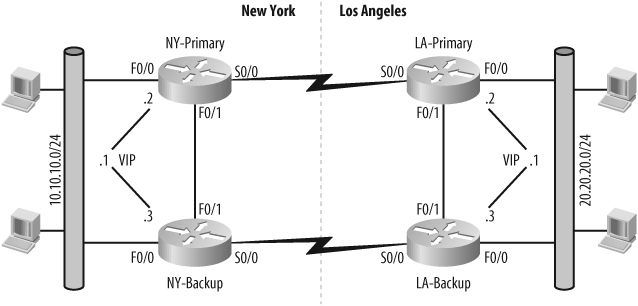When HSRP Isn't Enough
HSRP is an awesome tool, and with the addition of interface tracking, it can be the means for near total redundancy. There are situations, however, where HSRP is not enough. The example I will show here is one of my favorite interview questions, because usually only someone with real-world experience in complex networks has seen it.
Figure 13-4 shows a deceptively simple HSRP setup. Two locations, New York and Los Angeles, are connected via two T1s. The routers on either side are connected via the F0/1 interfaces, and HSRP is implemented with interface tracking on the F0/0 interfaces. The idea here is that if either of the primary routers should fail, the secondary routers will take over for them. Additionally, should the primary T1 link fail, the secondary link should take over because interface tracking is enabled.

Figure 13-4. Two-link failover scenario using HSRP
Here are the primary Ethernet configurations for each router:
NY-Primary:
interface f0/0 ip address 10.10.10.2 255.255.255.0 standby ip 10.10.10.1 standby preempt standby track Serial0/0 10
NY-Secondary:
interface f0/0 ip address 10.10.10.3 255.255.255.0 standby ip 10.10.10.1 standby priority 95 standby preempt standby track Serial0/0 10
LA-Primary:
interface f0/0 ip address 20.20.20.2 255.255.255.0 standby ip 20.20.20.1 standby preempt standby track Serial0/0 10
LA-Secondary:
interface f0/0 ip address ...
Get Network Warrior now with the O’Reilly learning platform.
O’Reilly members experience books, live events, courses curated by job role, and more from O’Reilly and nearly 200 top publishers.

